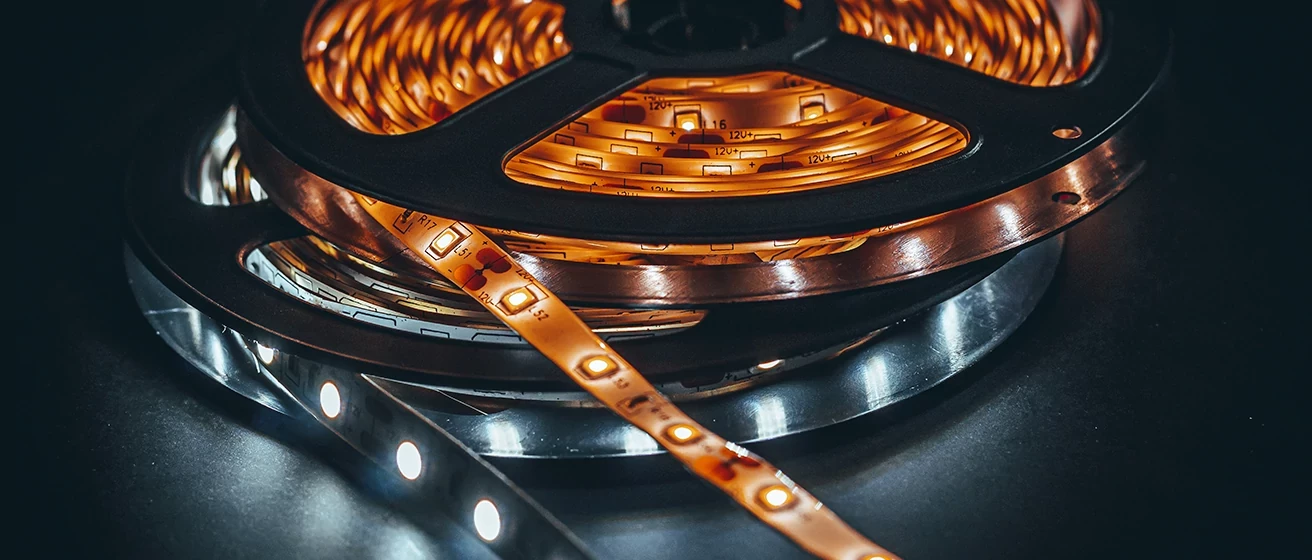What should you know before buying LED strip?
Where will you install LED light?
- What type of location are you in? Residential, commercial, retail, outdoors?
- Where will it be installed? Cabinets, steps, eaves, wall, Swimming pool?
- What specifically will you be lighting?
- What material will the lighting be attached to?
What Functions Do You Need?
- What kind of overall appearance do you want to achieve? Some special styling?
- Single color or RGB or RGBW?
- Dimmable LED lighting? Addressable LED lighting?
- If need high CRI for high color rendering?
- Which IP lever is required?
Expression Of Aesthetics & Emotion
What kind of emotion and aesthetics express do you want to achieve?
- Calm, Safe, Relaxed;
- Seductive, Energetic, Hopeful;
- Bold, Funny?
Top 4 Features You Must Know Before Buying LED Strip Light!
1. Color
1.1 Confirm The Color Type
After your clear preview of whole project, the first thing comes out is to confirm what color required. Single white color or dual white? RGB, RGBW or Addressable?
- RGB (multicolor)
- RGBW / RGBWW (multicolor + white / multicolor + warm white)
- CW / WW / NW (Cool White / Warm White / Neutral White)
1.2 Confirm The CCT
CCT - Correlated Color Temperature, It is for regular white color and to measure how warm or cool a light’s color is.
- 2700-3000K: This is a comfortable, cozy glowing light that is commonly used for lighting wooden furniture.
- 3000-4000K: This color temperature produces a warm glow in white color for office rooms or kitchens.
- 4000-4500K: For a neutral shade in white color used mostly in offices or schools. This shade is best for reducing eye strain.
- 5000-6500K: Produces a bright white light and works best for areas that require high illumination in commercial displays.
1.3 Confirm The CRI
CRI - Color Rendering Index, measures the accuracy of light’s color under the light source. The CRI of sunlight defined 100, the higher the value, the closer the light is to the real daylight.
- CRI 95 – 100: Phenomenal color rendering. Colors appear as they should, subtle tones pop out and are accented, skin tones look beautiful, art comes alive, backsplashes and paint shows it’s true beautiful full saturation.
- CRI 90 – 95: Great color rendering! Almost all colors ‘pop’ and are easily distinguishable. Noticeably great lighting starts at a CRI of 90.
- CRI 80 – 90: Good color rendering, where most colors are rendered well. You may not see items as fully saturated as you would like, but most people will not notice.
It is very important especially for Commercial Lighting. A high CRI is necessary for perfect display of your products.
2. Lumen -- Brightness
Lumen refers to the amount of light emitted by a lamp, which is what we usually call brightness. The reason why LED lamp is so popular is that its high lumen can play a role in environmental protection and energy saving. If you replace a standard 150-watt bulb that emits about 2600 lumens, a 25-watt LED is roughly the same. LED strips’ lumen output level varies depending upon the usage of your strips:
- 510-1150 lm/m: best for mood or accent lighting
- 570-1700 lm/m: mostly used for cabinet lighting
- 910-1430 lm/m: produces best task lighting which is close to the light source
- 1120-2250 lm/m: best used for task lighting that is away from its light source
- 1230-1840 lm/m: mostly used for indirect lighting in bedrooms or hotels
- 1640-3220 lm/m: for commercial usage or industrial lighting such as signage, linear lighting
3. LED SMD Type
LED SMD has many types, which come in different sizes with different wattages and lumens. In the EUROLED store you can find strips with the following types of SMD LEDs.
- 2835 SMD
- 5050 SMD
- 3528 SMD
- 335 SMD
4. IP Level
IP is an acronym “Ingress Protection”, a measurement standard ratings used to indicate the level of protection for electrical equipment against solids and liquids.
IP rating has two numbers, both of which give you information about the protection level. A higher number means greater protection against solids and liquids.
- The first number (0-6) refers to the level of protection against solid objects and moving parts, such as dust, debris, or other solid matter.
- The second number (0-8) refers the level of liquid and moisture protection.
- Below IP Rating chart can help you to better understand the protection offered with each IP Number.
Text credit: https://www.myledy.com
